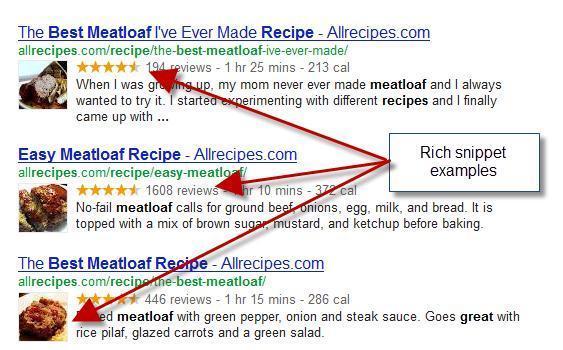What are Rich Snippets?
Rich Snippets refer to a type of structured data markup that allows search engines like Google to better decipher and understand what information is present on each web page. For business websites with multiple landing pages, rich snippets help search engines sift through the different pages so that the most relevant information is returned for specific queries.
First displayed in 2009 by Google, rich snippets take their shape in video thumbnails, preview images, and more to increase click-through rates on search engine results pages. Rich snippets include additional information that is not always stored in the meta description of the target site but is actually stored as structured data in its source code via markups.
Thanks to rich snippets, the attention of Internet users is guided towards a specific search result. In addition to this, rich snippets may offer some added value through event details, recipes. pictures, reviews, video snippets, and more.
Overall, rich snippets give users useful information displayed on the search engine results pages (SERPs) in both mobile and desktop searches.

Why are Rich Snippets Important?
When you do a search on Google, the search results will likely display the following 3 pieces of data every time:
- Title Tag
- URL
- Meta Description
A normal snippet looks like a title tag followed by a URL and a description. The whole thing is quick and concise an gives you just enough information to decide if you want to click on the site or not.
Rich snippets take a normal snippet and enhance it just a bit. They’re more eye-catching and give you just a bit more information to not just catch, but hold your attention. A typical rich snippet will have a title tag, URL, meta description, and then a little something extra. This is usually a review (i.e. a star rating), a thumbnail image, or the like.
This extra data is pulled by Google from the Structured Markup (or Schema) in your page’s HTML. With these extras, Internet users are more likely to notice and engage with a page, leading to an increased organic CTR and even possible conversions.
With this in mind, rich snippets are important because they take a little bit of information and help it go a long, long way.

How Are Rich Snippets Used for SEO?
It is important to note that, according to Google, rich snippets do not necessarily influence your website’s ranking. For this reason, they do not really count as ranking factors. Still, rich snippets can benefit SEO in a few different ways that are useful for business growth and engagement. These include:
Increased Attention
Thanks to the additional information present in rich snippets, search results are given much more attention by the average user. This helps webmasters to stand out from competing websites and search results so that their site gains the most traffic and engagement.
Improved Click-Through Rate
Data shows that the display of rich snippets causes CTRs in search engine results pages to rise dramatically with increased visits. In addition to this, higher click-through rates are commonly an important and positive user signal that marketing strategies are doing well and paying off, increasing a site’s overall ranking.
More Relevance
Since rich snippets are responsible for displaying additional and relevant information about a webpage, the click-through rate on that URL is actually improved. This means that the result is actually more relevant based on keywords and site content pulled from structured data, giving the user more information so that when they click, they are clicking with intention, not just to check and see if the site is what they’re looking for. Thanks to rich snippets improving relevance, the user knows they are heading to a relevant result each time.

How Do You Get A Rich Snippet?
Getting a rich snippet depends on the search engine you are using. The regulations that decide which rich snippets are displayed for which sites change regularly, meaning that your rich snippet may not always be the same from any given time period. For example, video-rich snippets were highly popular until they seemed to disappear in about 2014.
Today some sites do still display video rich snippets, but they are not widely seen for most brands. With the frequency of change in mind, it’s important to note that rich snippets will likely continue to change over time. Due to this, the best course of action is to prepare all your existing content for evergreen potential rich snippets. To do this, you have to optimize your content.
The best way to optimize your content potential snippets is to use a schema.org markup. This tool has been designed to offer a common system for Google, Bing, Yahoo, and most other search engines. The schema markup allows you to fill in various pieces of data about your content. For example, say you are doing a schema markup for an upcoming event. With the schema.org markup tool, you can fill in the following information with ease:
- Duration of the event
- Aggregate rating
- Location
- Organizer
- Performer
- Organization hosting the event
- Attendees
This is just some of the information you can add to a rich snippet. The possibilities are really endless.
When it comes to rich snippets, the bottom line is that these tools really provide more information about your website. To make a rich snippet worthwhile, your website has to be up to par with the competition within the SERP. This means optimized content, great information, clear navigability, and more.
Directive is the leading SEO agency for SaaS for finding these opportunities and ensuring your website ranks. Get a free proposal from us today to learn how Directive can take your marketing to the next level.